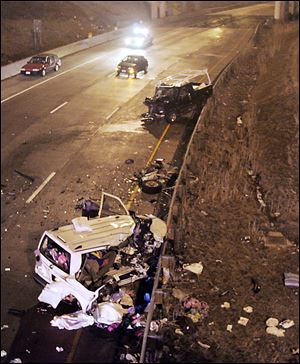
Ignition locks urged after DUI convictions
Wrong-way crashes spur plan
12/12/2012
A white van carrying a family of eight from Maryland lies crumpled against a guardrail on southbound I-280 near the Manhaten Blvd. exit in Toledo, Ohio in 2007. 5 members of the Maryland family died when a dark colored pickup shown against the guardrail (center) traveled the wrong way on the four-lane highway.
Citing statistics showing that 60 percent — if not more — of fatal wrong-way collisions on high-speed, divided highways involve intoxicated drivers, the National Transportation Safety Board on Tuesday urged all states to require breath-test devices in the vehicles of all drivers convicted of drunken or drugged driving.
The agency’s special-investigation report on wrong-way driving also urged safety researchers to “accelerate” development and implementation of on-board technology in vehicles to passively detect alcohol use, regardless of whether a vehicle operator has ever driven drunk.
The safety board’s recommendations were made less than a month after an Oregon, Ohio, woman was killed and four passengers in her car — three of them children — were injured in a head-on collision on a Tennessee freeway involving a wrong-way driver suspected of being drunk. The wrong-way driver was injured.
Alcohol has played a role in numerous wrong-way crashes in Toledo, including the Dec. 30, 2007, collision on I-280 that killed five members of a Maryland family headed home from a visit to relatives in Detroit.
Investigators found no evidence of intoxicants in a driver blamed for a head-on collision on northbound I-75 north of Bowling Green in March that killed three college students and the wrong-way driver.
No Toledo or Michigan crashes were among nine wrong-way collisions that safety-board staff reviewed to prepare the report, but they cited federal statistics showing that between 2004 and 2009, 1,566 fatal wrong-way crashes throughout the United States caused 2,139 deaths, and 69 percent of the wrong-way drivers had more than the 0.08 percent legal limit of alcohol in their bloodstreams.
Motorists age 70 or older accounted for 15 percent of wrong-way drivers, but only 3 percent of the “other” drivers in such collisions, which the agency said shows that age group’s “overrepresentation” among wrong-way drivers — especially considering that many seniors avoid driving at night, when most wrong-way crashes occur.
Stronger steps to combat drunken driving account for only some of the 16 recommendations in the report, which also urges development of better warning and vehicle-navigation systems to reduce wrong-way collisions and efforts to reduce older drivers’ disproportionate involvement in such crashes.
In response to local wrong-way crashes, the Ohio Department of Transportation this year is installing 218 wrong-way signs on freeway ramps, 38 pavement arrows made of thermoplastic material, and 76 other new sign assemblies in its Bowling Green-based district that covers Lucas, Wood, Ottawa, Sandusky, Seneca, Henry, Fulton, and Williams counties.
The pavement markings are complete and 90 percent of the signs are up, with the rest to be done by Dec. 31, Theresa Pollick, a spokesman for the department, said.
Better signs, highway design, and navigation systems “will help all drivers,” not just the elderly or impaired, Deborah A.P. Hersman, chairman of the safety board, said after its vote to adopt the report and its recommendations. But to get intoxicated drivers off the road, she said, states need to “do what is proven effective” with the use of ignition-interlock devices that keep cars from starting until their drivers provide a clean breath sample.
Although 17 states require installation of the devices in vehicles driven by all convicted drunken drivers, “it’s time for the next 33 states to step up for safety,” she said.
Ohio and Michigan are among those 33. Both states allow courts to order ignition interlocks for any drunken-driving conviction, but neither requires it for all first-time offenders.
Contact David Patch at: dpatch@theblade.com or 419-724-6094.